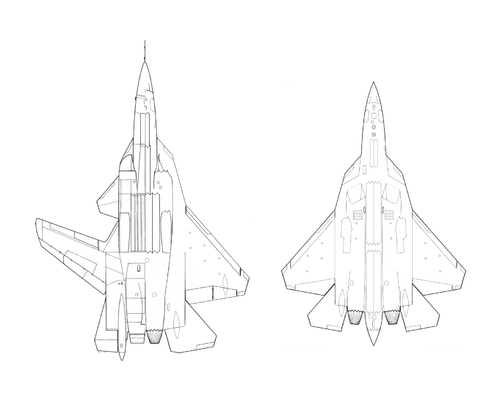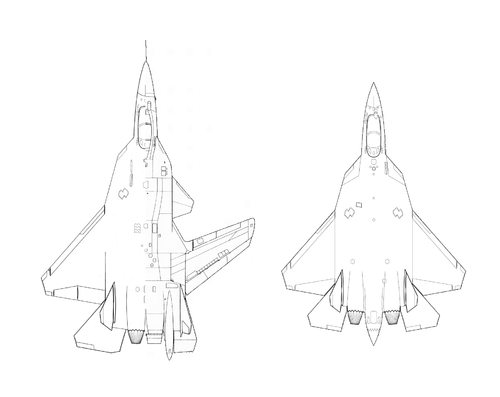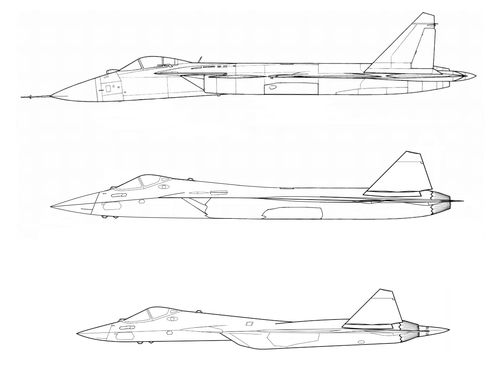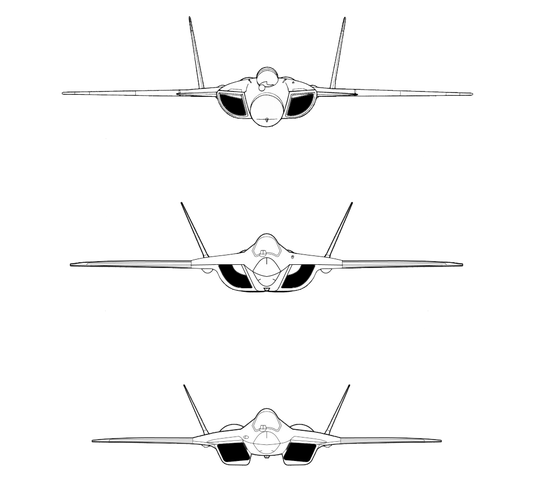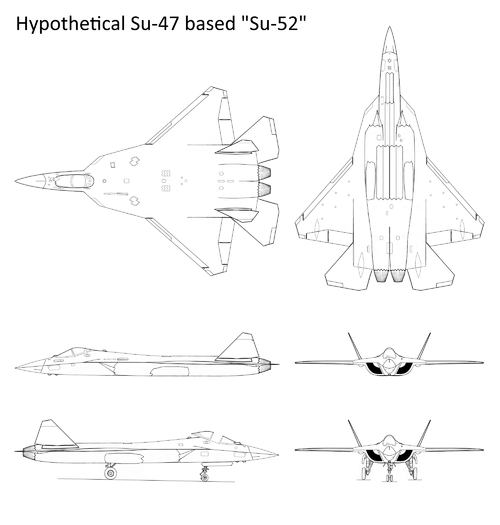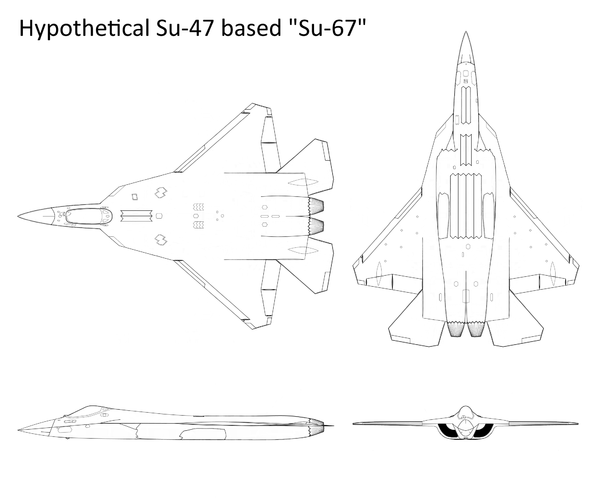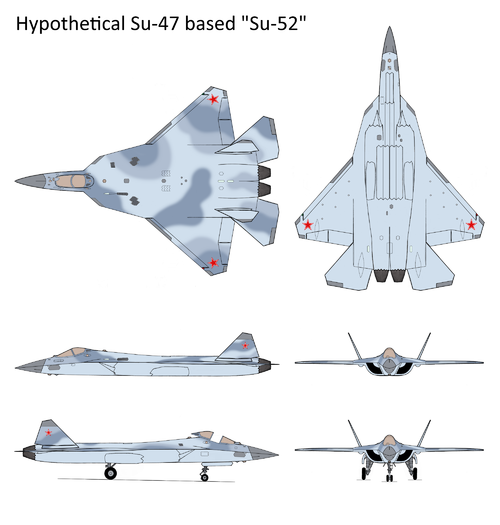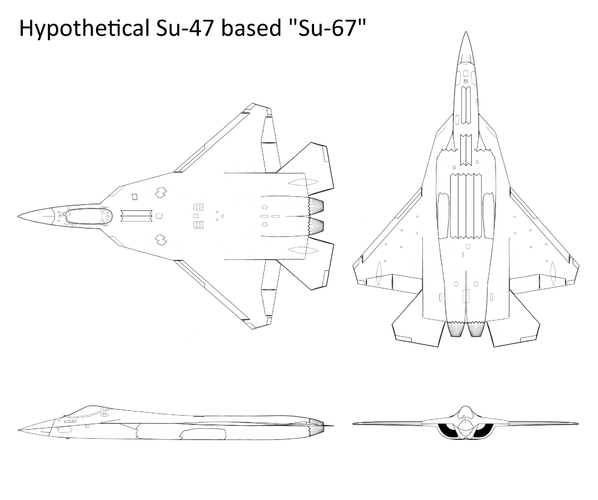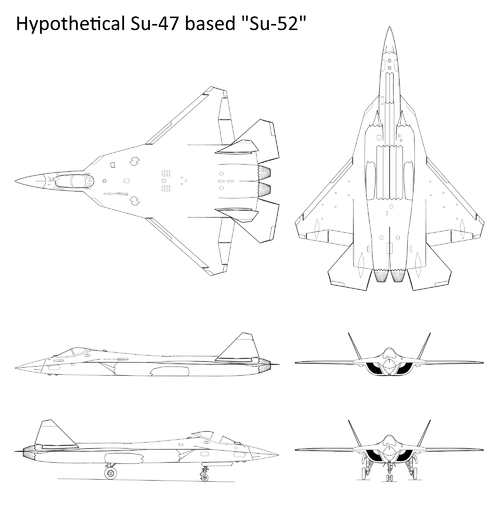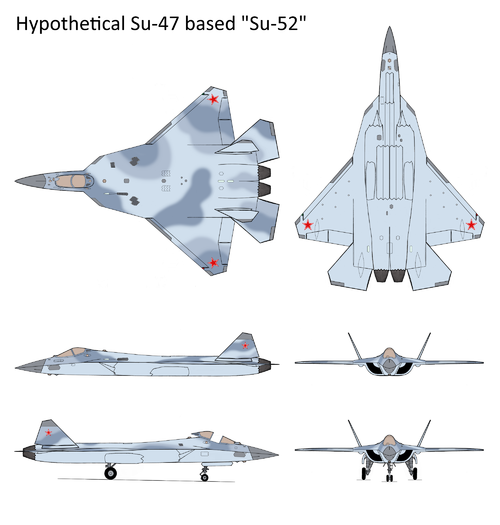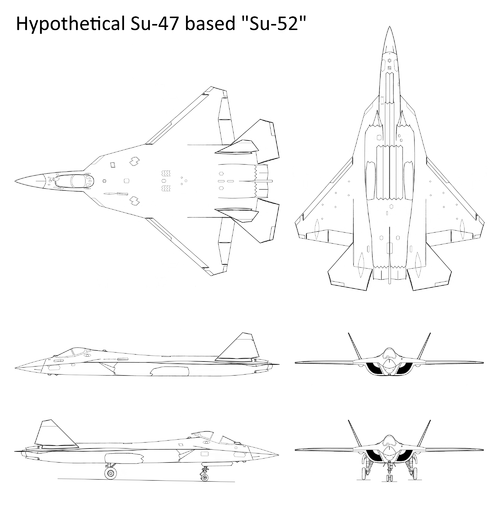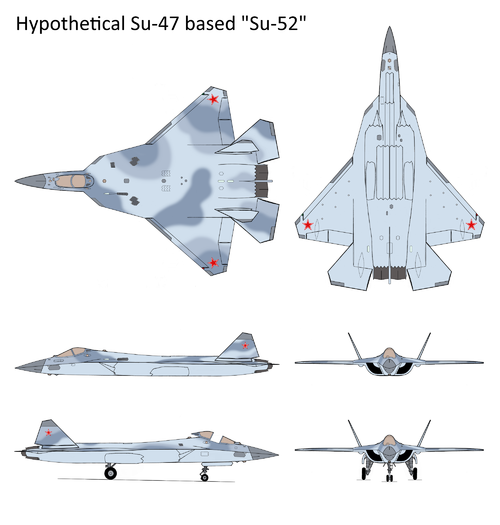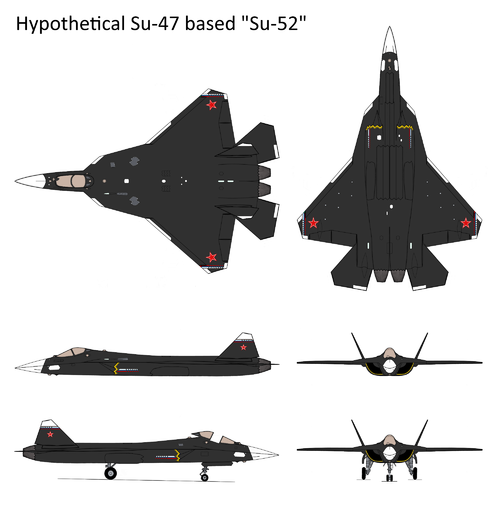Su-52? Well, (47+57)/2 = 52 
Which basically tells you what this is all about already, in a nutshell. An attempt to come up with a PAK-FA design on the basis of the Berkut airframe, taking advantage of ideas and solutions exemplified in the Su-57.
It strikes me that quite a few of the criticisms (legitimate as well as perceived) levelled at the T-50 configuration, particularly regarding LO properties, are avoided in the Su-47. Most prominently, it has fixed intakes with s-ducts which provide sufficient ground clearance and favourable positioning relative to the nose landing gear to obviate the need for FOD screens. The failure to adopt something like this is very commonly cited as a major RCS reduction shortcoming in the Su-57, though of course none of the critics has proved that a suitable blocker could not give similar results.
On the other hand, the unswept quarter circle inlet aperture is clearly not compatible with edge alignment requirements - the obvious solution would be to substitute a caret intake. I drew such a variant ages ago, but it would involve a considerable reshaping of the outer mold line on the lower fuselage flanks and in the meantime an alternative with good LO credentials has surfaced. In the NATF-23 carrier-based derivative of the Northrop/MDD ATF EMD configuration we find a layout that could replace the orginal Su-47 intake with far less impact. It basically involves serrating the inlet lip, adding a quarter shock cone to the upper inboard corner and removing the upper BL diverter gap (probably ok, as the shock cone acts as a semi-DSI). Orionblamblam got an eAPR sale out of this idea
Obviously, the forward swept wing, decidedly un-stealthy forward fuselage and empennage of the Berkut have to go. I've simply used suitably enlarged and adapted versions of the cockpit/nose section and flying surfaces of the Su-57 for this purpose, although the LEVCONs are not carried over.
I quite like the result, but it also gives a new appreciation for the real Su-57.
The most conspicuous feature of the "Su-52" in comparison is that it's naturally every bit as ginormous as the Su-47 was - quite a bit larger than even the J-20, we are talking MiG-31 territory here! It should therefore have greater fuel capacity and quite likely even greater fuel fraction, giving better range. Yet while the length & width of the main weapons bays are close to those of the Su-57 and it has a more elegant solution for carrying SRAAMs*, payload flexibility isn't really any better. Only the inboard part of each main bay could probably be made as deep as those on the Su-57 and they are slightly narrower, meaning it could likely only carry 2 heavy weapons internally as opposed to 4.
Therefore the more F-22-like** fuselage configuration that is proving so popular with other 5th generation fighter projects has a number of demonstrable drawbacks. And although the "Su-52" offers the same number of external hardpoints (6), the fact that all of them are underwing means the FOV for an external laser designator pod is more obstructed than on the T-50. Also, there is no straightforward place to put the rear high-band emitter that sits inside the Su-57 tail sting and closely-spaced engines might not offer the same roll authority with TVC. Last but definitely not least, the massive size increase would come with a correpsondingly painful hike in cost!
So, a certain lack of attention to detail in panel alignment and shaping of excrecences for LO not withstanding, the Su-57 emerges as a rather clever and efficient design in basic configuration.
* Or keeps them out of the main bays, compared to my "optimized Su-57" shown in these comparison drawings.
** Actually I'd say the closest analogue is arguably an early iteration of the naval variant of the F-23 which had conventional stabilizers (the definitive proposal got canards, of course). Wing config is quite different - trapezoid/diamond planform with fairly high aspect ratio and 3 flaperon segments as opposed to high-sweep delta with 2 segments - but this can be attributed to constraints imposed by carrier ops. In other respects, the resemblance is downright uncanny though: all but identical intake design (quarter-circle shock cone "semi-DSI" with serrated lip), framed canopy, same SRAAM bay layout, all-moving fins (though not reduced in area on the NATF-23)... All these things are markedly different on the F-22 which only really shares the lower fuselage aft of the intakes and the main weapons bay layout.
Which basically tells you what this is all about already, in a nutshell. An attempt to come up with a PAK-FA design on the basis of the Berkut airframe, taking advantage of ideas and solutions exemplified in the Su-57.
It strikes me that quite a few of the criticisms (legitimate as well as perceived) levelled at the T-50 configuration, particularly regarding LO properties, are avoided in the Su-47. Most prominently, it has fixed intakes with s-ducts which provide sufficient ground clearance and favourable positioning relative to the nose landing gear to obviate the need for FOD screens. The failure to adopt something like this is very commonly cited as a major RCS reduction shortcoming in the Su-57, though of course none of the critics has proved that a suitable blocker could not give similar results.
On the other hand, the unswept quarter circle inlet aperture is clearly not compatible with edge alignment requirements - the obvious solution would be to substitute a caret intake. I drew such a variant ages ago, but it would involve a considerable reshaping of the outer mold line on the lower fuselage flanks and in the meantime an alternative with good LO credentials has surfaced. In the NATF-23 carrier-based derivative of the Northrop/MDD ATF EMD configuration we find a layout that could replace the orginal Su-47 intake with far less impact. It basically involves serrating the inlet lip, adding a quarter shock cone to the upper inboard corner and removing the upper BL diverter gap (probably ok, as the shock cone acts as a semi-DSI). Orionblamblam got an eAPR sale out of this idea
Obviously, the forward swept wing, decidedly un-stealthy forward fuselage and empennage of the Berkut have to go. I've simply used suitably enlarged and adapted versions of the cockpit/nose section and flying surfaces of the Su-57 for this purpose, although the LEVCONs are not carried over.
I quite like the result, but it also gives a new appreciation for the real Su-57.
The most conspicuous feature of the "Su-52" in comparison is that it's naturally every bit as ginormous as the Su-47 was - quite a bit larger than even the J-20, we are talking MiG-31 territory here! It should therefore have greater fuel capacity and quite likely even greater fuel fraction, giving better range. Yet while the length & width of the main weapons bays are close to those of the Su-57 and it has a more elegant solution for carrying SRAAMs*, payload flexibility isn't really any better. Only the inboard part of each main bay could probably be made as deep as those on the Su-57 and they are slightly narrower, meaning it could likely only carry 2 heavy weapons internally as opposed to 4.
Therefore the more F-22-like** fuselage configuration that is proving so popular with other 5th generation fighter projects has a number of demonstrable drawbacks. And although the "Su-52" offers the same number of external hardpoints (6), the fact that all of them are underwing means the FOV for an external laser designator pod is more obstructed than on the T-50. Also, there is no straightforward place to put the rear high-band emitter that sits inside the Su-57 tail sting and closely-spaced engines might not offer the same roll authority with TVC. Last but definitely not least, the massive size increase would come with a correpsondingly painful hike in cost!
So, a certain lack of attention to detail in panel alignment and shaping of excrecences for LO not withstanding, the Su-57 emerges as a rather clever and efficient design in basic configuration.
* Or keeps them out of the main bays, compared to my "optimized Su-57" shown in these comparison drawings.
** Actually I'd say the closest analogue is arguably an early iteration of the naval variant of the F-23 which had conventional stabilizers (the definitive proposal got canards, of course). Wing config is quite different - trapezoid/diamond planform with fairly high aspect ratio and 3 flaperon segments as opposed to high-sweep delta with 2 segments - but this can be attributed to constraints imposed by carrier ops. In other respects, the resemblance is downright uncanny though: all but identical intake design (quarter-circle shock cone "semi-DSI" with serrated lip), framed canopy, same SRAAM bay layout, all-moving fins (though not reduced in area on the NATF-23)... All these things are markedly different on the F-22 which only really shares the lower fuselage aft of the intakes and the main weapons bay layout.

